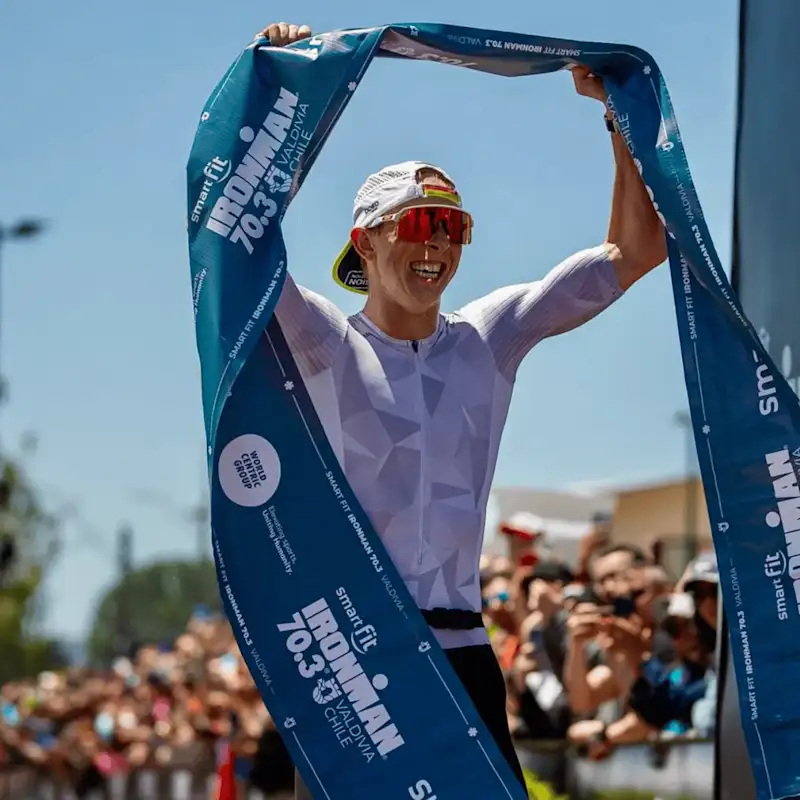
Colin Szuch
IRONMAN 70.3® St George
Colin's headline numbers
Colin's strategy
Fueling
Carbohydrate is the main fuel you burn when racing. Failing to fuel properly is a leading cause of underperformance in longer races.
Colin arrived in St George with a clear, well-practised fueling plan, aiming to carry all Three Key Levers for endurance nutrition (i.e. carbs, sodium, and fluid, as well as his caffeine) within his three bike bottles. This concentrated bottle approach is common across our elite 70.3® case study database as it allows athletes to be largely self-sufficient. However, one of the potential downfalls of this method is the risk of losing key carbs and electrolytes, which Colin unfortunately experienced when two of his bottles ejected on the ride, with Colin having only drunk half of each. Fortunately, Colin carries a little extra fuel in each bottle, so he was still able to average over 100g carbs per hour on the bike, keeping him well energised and focused. He didn’t take on any additional fuel on the run aside from a few cups of cola, a decision he later reflected on and felt he came close to emptying the tank. He noted that an extra gel early in the half marathon might’ve helped him avoid the small dip in energy he had around mile 8.
Hydration
Taking on board an appropriate amount of fluid and sodium is essential to maintaining blood volume and supporting the cardiovascular effort needed to perform on race day.
Whilst the absolute amount of sodium and fluid consumed per hour is important, it’s critical to consider these in relation to each other. This is known as 'relative sodium concentration' and it’s expressed in milligrams per litre (mg/L). How much sodium you’re taking in per litre of fluid is more important than the absolute amount taken in per hour.
Sweat sodium concentration (mg/L) is largely genetically determined and remains relatively stable. Knowing how salty your sweat is enables you to replace a good proportion of your sweat losses, which can range from 200-2,000mg/L.
Whilst Colin’s losses are on the moderate side, getting his hydration strategy right is still crucial when it’s hot and/or humid as his higher sweat rate in these conditions can result in significant net losses over the duration of a race.
Learn moreDespite losing two of his bike bottles, Colin still managed to average ~900ml/h on the bike by finishing his 1L (32oz) bottle, half of the other two, and picking up additional plain water before moving on to cups of water and cola on the run. Alongside this, he was proactive with his sodium replacement, aiming for a concentration of 1000mg/L, which is similar to that of his sweat. Despite the rising temperatures and not finishing all of his planned fluid, Colid avoided any major dip in performance or hydration-related issues. That said, he finished the race feeling dehydrated which could’ve been more limiting and led to hydration-related issues, like the cramping he experienced at IRONMAN® Texas earlier this season, had the race been any longer. Going forwards, collecting sweat rate data to help build a more proactive, individualised hydration strategy, along with a more secure bike bottle setup, would help limit the extent of dehydration and improve his ability to finish strong, especially in longer, hotter races.
Caffeine
Beyond the Three Levers of Performance (carb, sodium and fluid), caffeine is one of only a few substances that is proven to improve performance for most endurance athletes as it can help stave off mental and physical fatigue.
After testing the stimulant in training, Colin consumed a PF 30 Caffeine Gel 20 minutes before the start, then had ~two more PF 30 Caffeine Gels across the bottles he consumed on the bike. This put him comfortably within the recommended range to benefit from caffeine’s ergogenic effects. The caffeine was well timed to support his perceived energy levels and focus throughout the bike. For future races, he could consider adding one final PF 30 Caffeine Gel early on the run to help combat his feelings of fatigue later in races.
How Colin hit his numbers
Here's everything that Colin ate and drank on the day...
Colin's weapons of choice
Final thoughts
Colin's full stats
Data Confidence?
There is an adequate level of accuracy in the data collected and the numbers reported. The athlete manages to recall what they ate and drank including most specifics (brands flavours quantities plausible estimations of volumes). However there are estimations made within the data which affect the overall confidence level in the data reported.